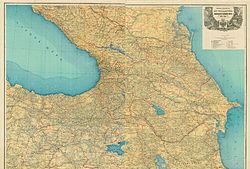1801–1917 → Established 1801 | Disestablished 1917 | |
 | ||
The Caucasus Viceroyalty was the Imperial Russian administrative and political authority in the Caucasus region exercised through the offices of glavnoupravlyayushchiy (Russian: главноуправляющий) (1801–1844, 1882–1902) and namestnik (наместник) (1844–1882, 1904–1917). These two terms are commonly, but imprecisely, translated into English as viceroy, which is frequently used interchangeably with governor general. More accurately, glavnoupravlyayushchij is referred to as High Commissioner of the Caucasus, and namestnik as Viceroy.
Over more than a century of tsarist rule of the Caucasus, the structure of the viceroyalty underwent a number of changes with the addition or removal of administrative positions and redrawing of provincial divisions.
History
The authority was established after the Russian annexation of the Kingdom of Kartli-Kakheti (eastern Georgia) in 1801. General Karl von Knorring was first to assume its governorship, being officially titled as the Commander-in-Chief in Georgia and Governor General of Tiflis (Tbilisi). Under the leadership of his successors, notably Prince Pavel Tsitsianov, General Aleksey Yermolov, Count Ivan Paskevich, and Prince Mikhail Vorontsov, Russian Transcaucasia expanded to encompass territories acquired in a series of wars with the Ottoman Empire, the Persian Empire, and local North Caucasian peoples. The scope of its jurisdiction eventually came to include what is now Georgia, Armenia, Azerbaijan, and the North Caucasus as well as parts of Northeastern Turkey (today the provinces of Artvin, Ardahan, Kars, and Iğdır).
Headquartered at Tiflis, the viceroys acted as de facto ambassadors to neighboring countries, commanders in chief of the armed forces, and the supreme civil authority, mostly responsible only to the tsar. From February 3, 1845, to January 23, 1882, the viceregal authority was supervised by the Caucasus Committee, which consisted of representatives of the State Council and the ministries of Finances, State Domains, Justice, and Interior, as well as of members of special committees. After the 1917 February Revolution, which dispossessed Tsar Nicholas II of the Russian crown, the Viceroyalty of the Caucasus was abolished by the Russian Provisional Government on March 18, 1917, and all authority, except in the zone of the active army, was entrusted to the civil administrative body called the Special Transcaucasian Committee or Ozakom (short for Osobyi Zakavkazskii Komitet, Особый Закавказский Комитет).
